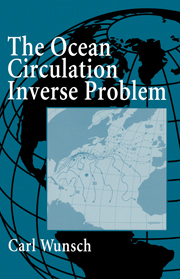4 - The Steady Ocean Circulation Inverse Problem
Published online by Cambridge University Press: 07 May 2010
Summary
The purpose of this chapter is to bring to bear the mathematical machinery of Chapter 3 onto the problem of determining the oceanic general circulation. The focus is on the thermal wind equations, as outlined in Chapter 2, but the methods apply to a broad variety of problems throughout oceanography and science generally. The approach initially will be to work with a dataset that has toylike qualities-far smaller in size than one would use in practice and hence inaccurate as a representation of the ocean. Nonetheless, the data are taken from real observations, have the structure of a real situation, and raise many of the problems of practice. This approach permits the working through of a series of estimation problems in a form where complete results can be displayed readily. Realistic problems present the same issues, but if the uncertainty matrices are 1000 × 1000, there are problems of display and discussion. Following these simple examples, the results of a number of published computations addressing the ocean circulation will be described.
The central idea is very simple: The equations of motion (2.1.1)–(2.1.5) are to be combined with whatever observations are available so as to estimate the ocean circulation, along with an estimate of the errors. Recall from Chapter 2, Equation (2.5.1), that knowledge of the density field in a steady flow satisfying the thermocline equations (2.1.11)–(2.1.15) is formally adequate to determine completely the three components of the absolute velocity. But because the observed density field is corrupted owing to sampling errors, it cannot be assumed to be consistent with the equations of motion.
- Type
- Chapter
- Information
- The Ocean Circulation Inverse Problem , pp. 212 - 296Publisher: Cambridge University PressPrint publication year: 1996
- 1
- Cited by



